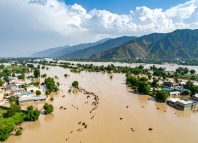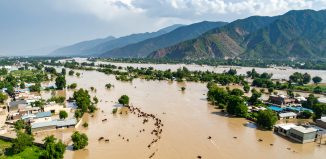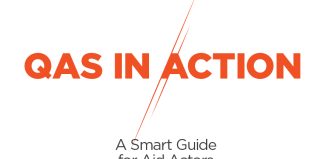Enabling disaster prone communities to live safer and protected lives
Afghanistan is prone to flash floods since many of its provinces are mountainous with steep slopes running into headwaters. Last year’s (2022) unseasonal flooding was catastrophic for communities living in such regions in Afghanistan. The scale of destruction was unparalleled. Flash floods swept away roads and other critical infrastructure such bridges, wheat mills, hospitals and schools. People lost their businesses, and families witnessed their homes swept away and many acres of farmland destroyed.
Since 2017, Community World Service Asia and the Ministry of Foreign Affairs of Japan, with the technical support of CWS Japan, has been implementing disaster risk reduction projects in east and central provinces of Afghanistan to increase the disaster risk reduction (DRR) capacities of local communities residing in such hazard prone areas.

The first phase of the project focused on enhancing community and relevant stakeholders’ knowledge on DRR and conducting risk assessments. The second phase aims to initiate interventions that implement mitigation measures as identified in risk assessments of various areas. Nine villages have been assessed through technical surveys, followed by initiation of construction work to mitigate the risks identified.
One of the villages assessed under the project is Sarband village of Khewa District1. Sarband is prone to frequent flash floods as it is located in the mountains part of Nangarhar province. The valleys on the southern side of the village bring down rainwater onto the village, causing flash floods every year. More than five hectares of agricultural land, 300 families, a mosque, a cemetery, and infrastructure and irrigation systems have been affected by these flood waters in the past three years. “The devastation caused by the flash floods would have been very large in scale here. I have lost my livestock and harvest in the past due to these floods since we would use traditional methods to prevent flooding which would not be effective to mitigate the damage. However, this year Community World Service Asia intervened at a good time and took measures to prevent the damage caused by the floods,” said Abdul, a community member of Sarband.

The DRR project has been working with hazard prone rural communities, government bodies and academia to enhance disaster risk reduction capacity of local communities and build their resilience against frequent climatic and natural hazards. Under the said project, a technical survey was carried out after which a protection wall and dams were designed by the DRR Technical Team with the support of Japan Conservation Engineers (JCE). The construction of the walls began on 11th December 2022 and were completed on 4th March 2023. The village now is protected by a 110-meter-long protection wall and 10 check dams have been built to store the flood water. “The construction of the check dams has increased the level of the water tables, which has allowed us to build wells. This is a significant achievement in eliminating the drought risk in the surrounding area,” shared Gul, a resident of the village.

With the implementation of this project, flood and landslide risks of many communities living in hazard prone areas have been reduced. This construction has been said to have brought great changes in the lives of these communities, especially by reducing their vulnerability to disasters. “The construction of the wall has provided relief to the 300 households in the village. We used to live in fear but today we live in peace. The project teams’ strong coordination with the Provincial Disaster Management Authority is commendable. The continuous coordination allowed the construction process to be fast and productive. We appreciate such initiatives and encourage others to do the same,” says Safi, a PDMA representative.
1 Located in Nangarhar province of Afghanistan







